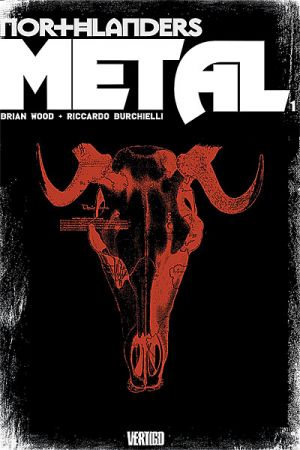- Comics
- Comics Reviews
- Manga
- Comics Reviews
- European Comics
- News
- Comics News
- Press Releases
- Columns
- Spotlight
- Digital Comics
- Webcomics
- Cult Favorite
- Back Issues
- Webcomics
- Movies
- Toys
- Store
- More
- About
By Andy Frisk
July 30, 2010 - 22:32
Wealthy and corrupt Christian monks are pouring large amounts of silver into a tiny Norwegian hamlet where they are building a monastery and a church. Hard times have befallen the hamlet and the Christians’ silver is the only way that the hamlet’s leader, Ulf, feels that he can lift it out of poverty. Erik, the town’s blacksmith, and the largest and most physically imposing resident of the hamlet, isn’t quite ready to suffer the insult to his religion that the construction and immigration of the corrupt Christians represent. After some scaffolding pins fail, nearly killing three men who are working on the project, Erik is removed from the project because, “a blacksmith is only as useful as his metal is reliable.” Whether or not Erik’s pins failed on purpose of not isn’t clear, but what is clear is that Erik’s metal will be tested further in more than one sense of the word. After Erik undergoes a mushroom induced hallucinatory meeting with the Norse goddess Hulda and he rescues an abducted and abused Norwegian nun, Erik is driven into revolt against the Christians.
 |
Brian Wood launches his latest Norse saga Metal with this swift moving first chapter titled “The Old Ways.” In a reversal of the plot of The Cross and The Hammer, where Wood told the story of an insurgent Irish Christian warrior against pagan Viking invaders, it’s the pagan Norseman in revolt against Christian economic and cultural invaders. Erik, the hulking Norwegian blacksmith, isn’t accompanied by an imaginary companion like Magus was in The Cross and The Hammer, although he is spurred on by hallucinatory visitations from the Norse goddess Hulda who encourages his actions. Erik is accompanied by Ingrid, a captive and forcibly converted nun whom Erik frees, who also shares Erik’s revulsion towards the Christians’ actions and attitudes toward their old ways (the “old ways” of the chapter’s title). Wood speeds along the action in chapter one and sets up the following chapters as potential action and hallucination packed installments. Wood’s last saga, the superb Plague Widow, was relatively slow moving in its early chapters. Metal looks to move more swiftly, but doesn’t look to be less strong in storytelling structure, at least in light of the strengths of the first chapter. Wood’s also continues his relevant storytelling by introducing yet another socio-political conflict between religions which is spurred on by economic concerns, much like religious conflicts and wars are spurred on by economics in our world today. Like Wood’s other Northlanders’ stories though, there won’t be any easy answers or tidy resolutions in Metal.
DMZ’s regular artist Riccardo Burchielli handles the artistic duties this time. His style is very similar to Plague Widow’s artist Leandro Fernandez. Burchielli’s depictions of the vast Norwegian landscape are similar to Fernandez’s landscapes. Burchielli’s background and anatomy work are also very close to Fernandez’s as well. Burchielli’s facial expressions border on caricature though in opposition to Fernandez’s realistic and emotion filled facial depictions. Both artists do a great job recreating Viking era dress, both domestic and militaristic. Simply stated, Burchielli’s artwork meets the standard set by Northlanders’ previous artists while maintaining the striking visual appeal of the series.
Northlanders is 30 issues along now at this point, it,s and is still going strong. Brian Wood’s masterful series continues to be a top of the monthly reading stack book that is astounding in its continued and consistent high quality.
Rating: 10 /10